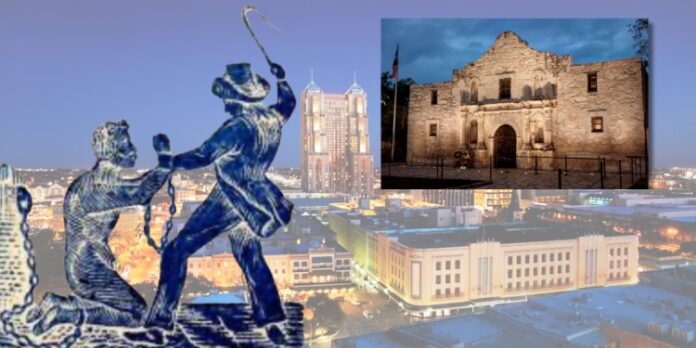Slaves in San Antonio: Thirty-Nine Lashes
People who try to make up Black history often try to act like San Antonio treated Black people nicely. This is being done now as some want people to believe that the Alamo had nothing to do with slavery. They sold slaves at the Alamo in 1861 and even had slave codes during that time. Section 2 of the slave code in San Antonio read, “Every slave who shall be found at large in the streets of said city or off the premises of his or her owner, employer, or the person having the legal charge of such slave, after fifteen minutes, after the hour specified in the preceding section, without a written pass or permit, from the master, mistress or such person having the legal custody or charge of such slave, which pass shall not extend beyond one night and shall state the purpose for which it was given, shall be apprehended by any marshal, or police officer of the city, and be detained in custody, in jail of said city, or otherwise, until the next morning . . . .”
“That every slave or slaves, who shall be found occupying any house, building, room, or premises separate, and apart from the premises of the owner or person having the legal charge or control of such slaves or slave, such house, room, building or premises not being occupied by some white person or persons, to whom the services of such slave or slaves may have been hired, shall be arrested, and punished by the infliction of not to exceed thirty-nine lashes . . . .”
San Antonio Slavery/Section 7
The law went even further in describing the horrors of San Antonio slavery in Section 7 by saying, “That every slave or slaves, who shall be found occupying any house, building, room, or premises separate, and apart from the premises of the owner or person having the legal charge or control of such slaves or slave, such house, room, building or premises not being occupied by some white person or persons, to whom the services of such slave or slaves may have been hired, shall be arrested, and punished by the infliction of not to exceed thirty-nine lashes . . . .” Section 17 even spelled out the punishment for Black people for playing cards. It read, “That no slave or free person of color shall be permitted to play at cards, or any other game of chance, and any slave or free person of color so offending shall, on conviction, be punished by the infliction of not exceeding twenty lashes, which punishment may be remitted by the mayor upon payment by the owner, or person having control over such slave, a fine to be assessed by the Mayor, of not less than five nor more than ten dollars, and the cost of the proceedings.” San Antonio had an ugly racist past just like any other slave owning Confederate State in the South.
There were also plenty of slave plantations in Bexar County and the surrounding area. One plantation was the Robert W. Brahan slave plantation right off Broadway Street at the back of Fort Sam and he owned 59 slaves. There is a street still named after this racist at the location and is now called the West Fort Neighborhood. Interestingly, the die hoards of Alamo myth have honored a mulatto slave master named Hendrick Arnold who supported slave owners and sold his own daughter into slavery. Unfortunately, the Alamo Trust Board continues to dabble in racist lies about the Alamo and racism in San Antonio. Several artists were suckered punched into building a statue of Arnold at the Alamo who was a disgrace to freedom. There were 18 slave catcher districts in Bexar County that the Bexar County Commissioners Court were authorized to pay after a Seminole Native American, named Wild Cat, vowed to free slaves in the area. One such district was District No. 2, and included Asa Mitchell. Asa Mitchell controlled a slave plantation at Mitchell Lake and now the Mitchell Lake Audubon Center.





